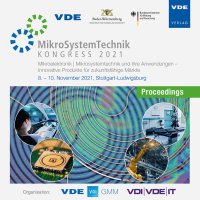GaN-based pressure sensor for harsh environments with on-chip temperature compensation
Conference: MikroSystemTechnik Kongress 2021 - Kongress
11/08/2021 - 11/10/2021 at Stuttgart-Ludwigsburg, Deutschland
Proceedings: MikroSystemTechnik Kongress 2021
Pages: 4Language: englishTyp: PDF
Authors:
Moser, Matthias; Scherjon, Cor; Pradhan, Mamta; Alomari, Mohammed (Institut für Mikroelektronik Stuttgart (IMS CHIPS), Stuttgart, Germany)
Burghartz, Joachim (Institut für Mikroelektronik Stuttgart (IMS CHIPS), Stuttgart, Germany & Institut für Nano- und Mikroelektronische Systeme (INES), Stuttgart, Germany)
Abstract:
Gallium Nitride (GaN)-based High-Electron Mobility Transistors (HEMTs) allow operation at high temperatures, where conventional Silicon (Si)-based transistors can no longer be used due to the high internal charge carrier generation. Due to the large band gap of GaN (3.4 eV), this charge carrier generation is significantly lower, which makes GaN HEMTs particularly suitable for high-temperature and power electronics. However, sensors that are to operate at high ambient temperatures can also be efficiently realized with GaN devices. In this work, a GaN-based pressure sensor for highpressure range up to 50 bar was modelled, designed and simulated. The simulation was based on the now standardized Advanced SPICE Model for High-Electron Mobility Transistors (ASM-HEMT). The sensor uses a Wheatstone Bridge (WB) circuit with four sensor elements placed on a membrane. The WB output signal is already largely temperaturecompensated due to the bridge configuration. A monolithic integrated differential amplifier was used to amplify the differential signal of the bridge circuit, which uses an integrated current mirror to compensate temperature effects. The Integrated Circuit (IC) shows almost complete compensation of the temperature drift up to 400 °C. The optimized sensor requires operating voltages of 24 V and 12 V. The final sensor structure shows a high and constant sensor sensitivity of 7.85 mV/barV also in high-pressure range with high temperature stability and a linearity of 0.4 %FSO.


